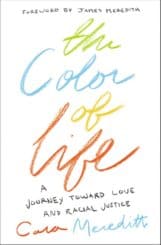
I remember the day that I saw a blog post written by my friend Cara Meredith, repenting of her use of the moniker “Hot Black Husband” (HBH) to refer to her husband, James.
“Such a reference objectifies him,” Cara wrote. “It devalues his identity by placing the ‘black’ descriptor before his more important role as my husband.”
She concluded the post with the following: “And if my name for him has offended you, I ask your forgiveness. I’m learning and I’m growing and I’m messing up on this journey…. So, please, forgive me.”
I knew Cara as a voice for racial justice and yet, here she was, proclaiming in very public fashion that she had been making a mistake for years and asking for forgiveness from friends and strangers alike.
This journey, as well as this same tone of humility and grace, is the cornerstone of Cara Meredith’s new book, The Color of Life: A Journey Toward Love and Racial Justice. The former English teacher and parachurch minister is clear that she does not have all the answers when it comes to the deeply painful, complicated issues of race that continue to plague the United States. But she does have a story to tell.
“I ask your forgiveness. I’m learning and I’m growing and I’m messing up on this journey…. So, please, forgive me.”
The Color of Life begins with Cara meeting her soon-to-be husband, James Henry Meredith, through eHarmony. She is quickly smitten by him and all the ways he is different from her, including his left-brained way of thinking, his sober outlook on life, and the fact that he is black, while she is white.
Then, on their third date, James sits her down and explains that his father is the James Meredith: the first black man to integrate, and graduate from, the University of Mississippi; the instigator of the March Against Fear who survived an attack by a white sniper; and a civil rights icon.
Having worked with underprivileged youth who were primarily youth of color, Cara had been exposed to racial inequities and tensions. Yet she is unflinchingly honest about her own lack of empathy and understanding prior to meeting James. “Had all of this not mattered to me because it hadn’t affected me personally? Had I not cared about issues of race and justice and civil rights because I was white and he was black, because although this was a part of his history, I hadn’t believed it a part of my history? Surely this hadn’t been my fight to fight, my responsibility to bear,” she writes.
It is through love—first of her husband, then of their two young mixed-race sons—that Cara finds the courage to delve deeply into the history of her own family and community, and that of the Meredith family, even when the journey takes her to difficult places. She takes on the exclusionist history of her home state of Oregon, the only state in the union ever to approve “a law that prohibited anyone of African American descent from coming into, residing in, or being within the state’s borders.” She writes about past restrictions against interracial marriage and the threats faced by mixed-race children in American history. She retells, in vivid detail, how her father-in-law came to attend the University of Mississippi over the objections of an entire state government. She discusses slavery, the gruesome murder of Emmett Till, and the many black lives that have been lost to police brutality in recent years.
The heartbeat of The Color of Life ultimately resides in the narration of these events—because, for Cara Meredith, these have become personal stories. This is no dry recitation of long-ago incidents involving men and women of another era. These stories live and breathe because they are interwoven with her present, everyday life in tangible ways. They influence her marriage, her family gatherings, her profession, how she raises her sons, and the world they will one day lead.
The fact that all Americans, whether first-generation immigrants or descendants of passengers of the Mayflower, need to personally connect with our country’s painful history of race before true justice is possible is one of the most powerful takeaways from The Color of Life, and it’s one I wish Cara had spent more time exploring.
Cara quotes social activist and theologian Rev. Dr. Ruby Sales, who says to a group of Christian women on a pilgrimage, “Fighting for justice isn’t something we do for others, it’s something we do for ourselves. Every moment is nitty-gritty hard work that we do to redeem ourselves.” Cara readily reflects on what this means for her personally: “When Mama Ruby told me that justice was for me too, I was reminded that I could be made brand new. I am not held hostage by the color of my skin, nor am I in trouble with my history—even if a litany of apologies and reparations and change, on behalf of both my country and me, still needs to happen.” But, for the most part, she lets readers sit with this profound yet enigmatic statement and figure out for themselves how to live this out.
As an Asian American, I have often felt uncertain of my place in conversations about race. I have been readily welcomed into groups as another person of color; I have also been accused, because of my immigrant parents’ middle class background, of being “just another white person.” I have experienced prejudice from whites, as well as from African Americans, Hispanics, and other Asians. Depending on the context, I am both privileged and not; oppressor and oppressed; model minority and unwelcome outsider. What does redemption along the racial justice journey look like for someone like me?
Depending on the context, I am both privileged and not; oppressor and oppressed; model minority and unwelcome outsider. What does redemption along the racial justice journey look like for someone like me?
Unfortunately, The Color of Life stays mostly within the boundaries of the black-white divide, leaving open the question of what an American version of a “rainbow nation,” as coined by South African Archbishop Desmond Tutu, could look like.
These limitations point to the narrowness of the needle that Cara—and indeed, almost anyone who enters the American public discourse about race—is trying to thread. As a white woman, she wants to advocate for racial justice, but without speaking either for or over her sisters and brothers of color. She wants to be inclusive, yet it’s impossible for one book to capture the many complex forms that racial injustice takes in America. She wants to call her readers to a kingdom-redeemed society of full acceptance, while also acknowledging that the path to get there is murky, and we will probably all hurt others and be hurt along the way.
These days, it seems almost impossible to discuss race in America without misstepping or deeply offending someone. As a result, many are afraid to even try. Cara details decidedly awkward conversations with her own father, a typical hardworking, well-intentioned American who doesn’t want to see himself as complicit in racial inequities. She even shares uncomfortable interactions with her father-in-law, who is, unsurprisingly, a far more complicated figure than his historical significance might suggest. “Why are you writing this book?” James Howard Meredith demands of her over and over again. For him, his willing participation in this book is far more about his mixed-race grandsons than the white woman who stole his son’s heart.
But this is also where The Color of Life gets it absolutely right: any chance we as a society have to embody the African philosophy of Ubuntu—that every person is a person through other people—must be built upon a foundation of grace. Grace that allows us to see the Imago Dei in those who might deny our full humanity. Grace that encourages brothers and sisters who are trying their best, even when their efforts stumble. Grace to forgive others and ourselves, over and over again. Grace to reach out and have extremely awkward conversations. Grace to acknowledge that every individual, regardless of his or her race or background, has a meaningful story to tell.
Referencing the subtle and less-subtle racism sometimes expressed by her relatives, Cara writes, “Their stories I am, and my stories they are, for ours is a story of embracing, of repenting, and of becoming…. Then, sprinkling ourselves with a generous dusting of grace, we nod toward all the future saints: to my sons and to their cousins, to all those little ones born with fire in their bones. We honor them with a legacy of truth. And with tears in our eyes, we find a middle road, choosing to tell every side of the story.”
The Color of Life captures the many layers of Cara Meredith’s story with vulnerability and humility, without shirking from the pain and the difficult truths. In that regard, it is an important model for continuing along the path toward racial justice.
“There is nothing more valuable than the tramp, tramp of marching feet,” Dr. Martin Luther King, Jr., proclaimed at a 1966 rally in Chicago. The Color of Life encourages us to keep marching, to keep moving forward—even when it’s costly or we make distressing mistakes. The hope for future redemption, for a society in which we each love one another as Jesus loved us, is well worth all our imperfect efforts.
 Dorcas Cheng-Tozun is an award-winning writer, an Inc.com columnist, and the author of Start Love Repeat: How to Stay in Love with Your Entrepreneur in a Crazy Start-Up World. Previously a nonprofit and social enterprise professional, she served as the first director of communication and human resources for d.light, one of the world’s leading social-benefit companies. A native of Silicon Valley, Dorcas currently lives with her husband and two adorable hapa sons in Nairobi, Kenya.
Dorcas Cheng-Tozun is an award-winning writer, an Inc.com columnist, and the author of Start Love Repeat: How to Stay in Love with Your Entrepreneur in a Crazy Start-Up World. Previously a nonprofit and social enterprise professional, she served as the first director of communication and human resources for d.light, one of the world’s leading social-benefit companies. A native of Silicon Valley, Dorcas currently lives with her husband and two adorable hapa sons in Nairobi, Kenya.

